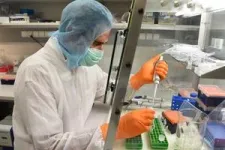(Press-News.org) When pathogens invade the body, the immune system must react immediately to prevent or contain an infection. But how do our defence cells stay ready when no attacker is in sight? Scientists from Vienna have found a surprising explanation: They are constantly stimulated by healthy tissue. This keeps them active and ready to respond to pathogens. Based on this insight, future medications could be devised to selectively enhance our immune system’s attention. The study has been published in the journal Nature Immunology (DOI: 10.1038/s41590-024-01804-1).
Communication is crucial in immune defence. When a virus infects a cell, the cell releases signalling molecules. This alerts immune cells, and our immune system is rapidly activated. Immune cells process such signals through the JAK-STAT signalling pathway – named after Janus, the two-faced Roman god of beginnings and endings. This pathway links signal detection on the cell surface to the core regulatory machinery of immune cells, activating a set of genes and putting the immune cells into attack mode.
Even when there is no immediate threat, our immune cells must remain vigilant. At the same time, they should not cause damage through unnecessary activity, as it is the case with autoimmune diseases. How our defence cells maintain this balance is poorly understood. A team of research groups from Vienna (www.jak-stat.at) has now put forward an explanation in the journal Nature Immunology: “The same JAK-STAT signalling pathway that activates immune cells during an infection also keeps them on standby when no pathogens are in sight,” explains Christoph Bock, Principal Investigator at CeMM and Professor at the Medical University of Vienna. When encountering a pathogen, the immune cells thus only need to increase the signalling intensity, which is much faster than turning on a completely new signalling pathway.
To reach this conclusion, the team examined twelve mutant mouse models, each with a genetically altered component of the JAK-STAT signalling pathway. These mice were raised free of diseases and compared with genetically unaltered mice. It was observed that the mutant mice lacked some of the characteristic gene activity and epigenetic regulation of the standby state. Something similar happened when defence cells were removed from their tissue environment and kept in cell culture: They lost their characteristic standby state and even parts of their identity as immune cells.
The team analysed the gene expression and epigenetics of immune cells and tissue samples collected by seven research teams from Vienna. “Our analyses were only possible due to the establishment of uniform laboratory standards and robust statistical methods,” explains bioinformatician Nikolaus Fortelny (first author and now Professor at the University of Salzburg). “We showed that JAK-STAT signalling has different functions when immune cells are on standby than during the active response to pathogens,” explains Matthias Farlik (also a first author and now group leader at the Medical University of Vienna).
“JAK-STAT signalling is a central mechanism of our body for communicating immune signals,” summarizes Thomas Decker (Professor at the Max Perutz Labs and the University of Vienna) the relevance of the study. “Our study provides insights into the role of the immune system: not only does it react to attacks, but it also maintains vigilance without causing unnecessary damage,” adds Mathias Müller (Professor at the University of Veterinary Medicine Vienna). Genes of the JAK-STAT signalling pathway are sometimes pathologically altered in individuals with immune diseases and cancer. Therefore, this research also provides possible approaches for future therapies.
###
The Study “JAK-STAT signaling maintains homeostasis in T cells and macrophages” was published in Nature Immunology on April 24, 2024. DOI: 10.1038/s41590-024-01804-1
Authors: Nikolaus Fortelny, Matthias Farlik, Victoria Fife, Anna-Dorothea Gorki, Caroline Lassnig, Barbara Maurer, Katrin Meissl, Marlies Dolezal, Laura Boccuni, Aarathy Ravi Sundar Jose Geetha, Mojoyinola Joanna Akagha, Anzhelika Karjalainen, Stephen Shoebridge, Asma Farhat, Ulrike Mann, Rohit Jain, Shweta Tikoo, Nina Zila, Wolfgang Esser-Skala, Thomas Krausgruber, Katarzyna Sitnik, Thomas Penz, Anastasiya Hladik, Tobias Suske, Sophie Zahalka, Martin Senekowitsch, Daniele Barreca, Florian Halbritter, Sabine Macho-Maschler, Wolfgang Weninger, Heidi A. Neubauer, Richard Moriggl, Sylvia Knapp, Veronika Sexl, Birgit Strobl, Thomas Decker, Mathias Müller, Christoph Bock
Funding: This work was supported by the Austrian Science Fund (FWF), the European Molecular Biology Organization (EMBO) and the European Research Council (ERC).
The CeMM Research Center for Molecular Medicine of the Austrian Academy of Sciences is an international, independent and interdisciplinary research institution for molecular medicine under the scientific direction of Giulio Superti-Furga. CeMM is oriented towards medical needs and integrates basic research and clinical expertise to develop innovative diagnostic and therapeutic approaches for precision medicine. Research focuses on cancer, inflammation, metabolic and immune disorders, and rare diseases. The Institute's research building is located on the campus of the Medical University and the Vienna General Hospital.
www.cemm.at
The Medical University of Vienna (MedUni Vienna) is one of the longest-established medical education and research facilities in Europe. With almost 8,000 students, it is currently the largest medical training centre in the German-speaking countries. With more than 6,000 employees, 30 departments and two clinical institutes, twelve medical theory centres and numerous highly specialised laboratories, it is one of Europe's leading research establishments in the biomedical sector. MedUni Vienna also has a medical history museum, the Josephinum.
www.meduniwien.ac.at/
The Max Perutz Labs are a research institute established by the University of Vienna and the Medical University of Vienna to provide an environment for excellent, internationally recognized research and education in the field of Molecular Biology. Dedicated to a mechanistic understanding of fundamental biomedical processes, scientists at the Max Perutz Labs aim to link breakthroughs in basic research to advances in human health. The Max Perutz Labs are located at the Vienna BioCenter, one of Europe’s hotspots for Life Sciences, and host more than 40 research groups, involving around 400 scientists and staff from more than 50 nations.
www.maxperutzlabs.ac.at
The University of Veterinary Medicine, Vienna in Austria is one of the leading academic and research institutions in the field of Veterinary Sciences in Europe. About 1,500 employees and 2,500 students work on the campus in the north of Vienna which also houses five university clinics and various research sites. Outside of Vienna the university operates Teaching and Research Farms. Two research institutes on Vienna's Wilhelminenberg as well as a teaching and research estate in Lower Austria and a branch in Tyrol also belong to the Vetmeduni. The Vetmeduni plays in the global top league: in 2023, it once again took top place in the subject "Veterinary Science" in the world-wide Shanghai University Ranking.
http://www.vetmeduni.ac.at
The Paris Lodron University of Salzburg, PLUS, boasts six faculties with 34 departments and 87 degree programmes in digital and analytical, natural and life sciences, social sciences and cultural studies, law and economics, and theology. Almost 18,000 students are enrolled in bachelor’s, master’s and doctoral programmes here. Founded in 1622 by Prince Archbishop Paris Lodron and reestablished in 1962, today the PLUS is the largest educational institution in Salzburg.
ttps://www.plus.ac.at/
For further information please contact:
Stefan Bernhardt
PR & Communications Manager
Phone +43-1/40160-70 056
Fax +43-1/40160-970 000
sbernhardt@cemm.at
CeMM
Research Center for Molecular Medicine
of the Austrian Academy of Sciences
Lazarettgasse 14, AKH BT 25.3
1090 Vienna, Austria
www.cemm.at
END
Ready and vigilant: immune cells on standby
2024-04-24
ELSE PRESS RELEASES FROM THIS DATE:
Securing competitiveness of energy-intensive industries through relocation: The pulling power of renewables
2024-04-24
“Our new study shows that renewable-scarce countries like parts of the EU, Japan and South Korea could save between 18 to 38 percent in production costs”, explains Philipp Verpoort, scientist at the Potsdam Institute for Climate Impact Research (PIK) and lead author of the study published in Nature Energy. “They could do so by relocating their production of industrial basic materials like green steel and chemicals based on green hydrogen to countries where renewable energy is cheap.” The use of renewable electricity and green hydrogen is ...
CAR T cell therapy targeting HER2 antigen shows promise against advanced sarcoma in phase I trial
2024-04-24
HOUSTON – (April 24, 2024) – Researchers at Texas Children’s Cancer Center and the Center for Cell and Gene Therapy at Baylor College of Medicine, Texas Children’s Hospital and Houston Methodist published results of a phase I clinical trial of a novel immunotherapy for high-risk sarcomas in the journal Nature Cancer.
The therapy uses chimeric antigen receptor (CAR) T cells engineered to target the HER2 protein, which is overexpressed on the surface of sarcoma cells. The HEROS 2.0 trial showed that this therapeutic approach is safe and is associated with clinical benefit.
“CAR T cell therapy has been a highly successful strategy for recurrent ...
Social change may explain decline in genetic diversity of the Y chromosome at the end of the Neolithic period
2024-04-24
The emergence in the Neolithic of patrilineal1 social systems, in which children are affiliated with their father's lineage, may explain a spectacular decline in the genetic diversity of the Y chromosome2 observed worldwide between 3,000 and 5,000 years ago. In a study to be published on 24 April in Nature Communications, a team of scientists from the CNRS, MNHN and Université Paris Cité3 suggest that these patrilineal organisations had a greater impact on the Y chromosome than mortality during conflict.
This ...
Aston University research finds that social media can be used to increase fruit and vegetable intake in young people
2024-04-24
The research team asked one group of participants to follow healthy eating accounts and another to follow interior design accounts
After just two weeks, participants following healthy eating accounts ate more fruit and vegetables and less junk food
Even minor tweaks to social media accounts could result in substantial diet improvements in young adults.
Researchers from Aston University have found that people following healthy eating accounts on social media for as little as two weeks ate more fruit and vegetables and less junk food.
Previous ...
A vaccine to fight antibiotic resistance
2024-04-24
Driven by the overuse of antimicrobials, pathogens are quickly building up resistances to once-successful treatments. It’s estimated that antimicrobial-resistant infections killed more than 1 million people worldwide in 2019, according to the World Health Organization.
“There are worries that at the rate things are going, in perhaps 20 or 30 years, few of our drugs will be effective at all,” said Xuefei Huang, a Michigan State University Research Foundation Professor in the departments ...
European Hormone Day 2024: Endocrine community unites to raise public awareness and push for policy action on hormone health
2024-04-24
European Hormone Day 2024: Endocrine community unites to raise public awareness and push for policy action on hormone health
European Hormone Day returns for the third year today, 24 April 2024, putting a spotlight on the vital role of hormones in chronic diseases such as diabetes, thyroid disorders, cancer and obesity, as well as many rare diseases.
The European Society of Endocrinology (ESE), the European Hormone and Metabolism Foundation (ESE Foundation), and partners from key groups and organisations across Europe and beyond will join forces to highlight simple steps we can all take towards better hormone health.
This builds on the success of the previous ...
Good heart health in middle age may preserve brain function among Black women as they age
2024-04-24
Research Highlights:
Middle-aged Black women with better heart health were less likely to show a decline in mental function compared with middle-aged Black women with worse heart health.
In this study, heart health was unrelated to cognitive decline among middle-aged white women.
A clinical trial is required to confirm if improving heart health among middle-aged Black women may slow cognitive decline and decrease the risk of dementia.
Embargoed until 2 a.m. CT/3 a.m. ET Wednesday, April 24, 2024
DALLAS, April 24, 2024 ...
The negative effects of racism impact sleep in adolescents
2024-04-24
Sleep and sleep disturbances have consequences for the development of adolescents and young adults. In a new article, researchers examine sleep during these periods, focusing on the effects of ethnic and racial discrimination. They conclude that improving sleep may boost health for all youth, but especially for those affected by racism.
The article, by researchers at Fordham University and the University of Illinois at Urbana-Champaign, appears in Child Development Perspectives, a journal of the Society for Research in Child Development.
“Discrimination ...
Study uses wearable devices to examine 3- to 6-year-olds’ impulsivity, inattentiveness
2024-04-24
Why do some young children struggle to sit through a story one day but not the next? Why do they rush impulsively into one activity but not another? Parents and teachers often focus on individual differences as they prepare children for formal schooling, but traditional measurement approaches make it difficult to study fluctuations in children’s behavior.
In a new study, researchers sought to understand children’s impulsive and inattentive behaviors in early education classrooms by having students use wearable devices called accelerometers to collect an intensive time series of their movement at school. The study found that children modulated their ...
Will future hurricanes compromise New England forests’ ability to store and sequester carbon?
2024-04-24
Nature-based climate solutions can help mitigate climate change, especially in forested regions capable of storing and sequestering vast amounts of carbon. New research published in Global Change Biology indicates that a single hurricane in New England, one of the most heavily forested regions in the United States, can down 4.6–9.4% of the total aboveground forest carbon, an amount much greater than the carbon sequestered annually by New England’s forests.
The work revealed that emissions from hurricanes are not instantaneous—it takes approximately 19 years for downed carbon to become a net emission, and 100 years for 90% of the downed carbon ...





